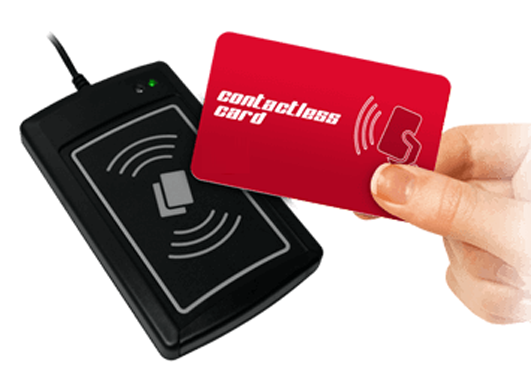

A NFC smart card is a contactless card also known as payment card. This type of card communicates with a terminal via NFC. NFC (Near-field communication) is a wireless communication technology that enables the exchange of data between devices that are a few centimeters apart. Usually one of these is a portable device or card.
 Example of an NFC smart card and reader
Example of an NFC smart card and readerNFC smart cards are commonly used to identify the owner to access public transport and buildings. Printers can use the NFC smart cards to authenticate the owner information against the user information stored on an LDAP directory server.
The authorization and authentication of the NFC smart card users are based on the PRISMAsync domain and user group configuration.
The NFC smart card usage leaves the existing PRISMAsync Print Server login method in place. So, when an NFC smart card reader is attached, users without a smart card can also have access to the control panel. Moreover, you can use NFC and PKI smart cards at the same time.
Before users can use their NFC smart cards to access the control panel you need to enable the NFC smart card usage in the Settings Editor.
There are smart cards and readers that can communicate without direct contact and use certificates to authenticate the owner. This authentication is based on PKI technology, but the interface uses NFC. Apply the PKI smart card configuration to enable these smart cards.
The NFC smart card chip contains a UID (user identifier) to identify one or more users.
PRISMAsync Print Server uses the UID (user identifier) on the NFC smart card to start user authentication. When there are more users with the same UID (user identifier), the login window of the control panel shows a list of user names to select from.
The UID (user identifier) can be displayed in several notations.
Example: UID (user identifier) notations on smart cards
|
PRISMAsync Print Server notation options |
Mifare smart card |
Felica smart card |
|---|---|---|
|
[As in card] |
00-FE-77-C7 |
01-19-02-10-81-15-6F-00 |
|
[Hexadecimal digits] |
00FE77C7 |
0119021081156F00 |
|
[Hexadecimal digits, reverse bytes] |
C777FE00 |
006F158110021901 |
|
[Decimal digits] |
16676807 |
79096738364092160 |
|
[Decimal digits, reverse bytes] |
3346529792 |
31267366478420225 |
Hexadecimal is a base 16 number; decimal is a base 10 number; binary is a base 2 number.
Hexadecimal digits are: 0, 1, 2, 3, 4, 5, 6, 7, 8, 9, A, B, C, D, E, F; decimal digits are: 0, 1, 2, 3, 4, 5, 6, 7, 8, 9; binary digits (bits) are: 0, 1.
A byte is a collection of 8 bits and represents 2 hexadecimal digits.
A 7-byte, hexadecimal notation is for example: 04 3A 98 CA BB 2B 80; The notation with reverse bytes becomes: 80 2B BB CA 98 3A 04.
|
Manufacturer |
Reader type |
|---|---|
|
Sony |
RC-S380 |
|
ACS |
ACR 122U (does not support Felica Lite cards) ACR1252U ACR1281U |
|
HID Global Corporation |
OMNIKEY 5427 Omnikey 5321 |
|
Manufacturer |
Reader type |
|---|---|
|
Felica |
Felica Felica Lite Felica Lite-S Felica, Felica Lite, Felica Lite-S IDPrime MD |
|
Mifare |
Mifare Classic Mifare Plus Mifare DESfire Mifare Ultralight |